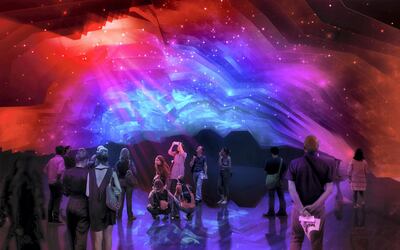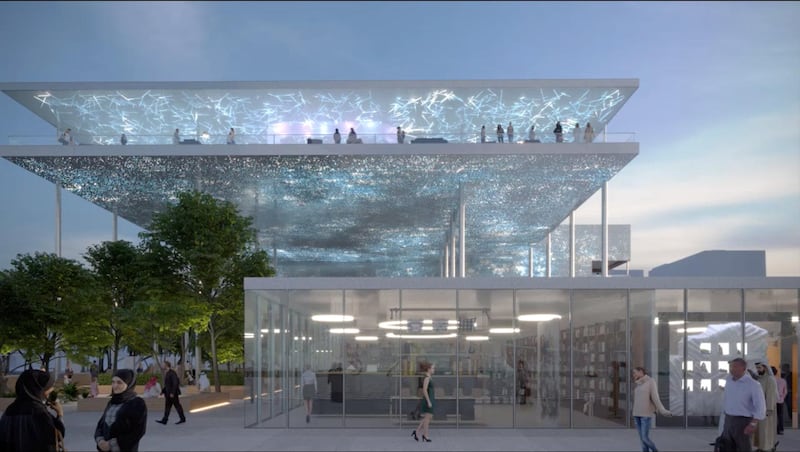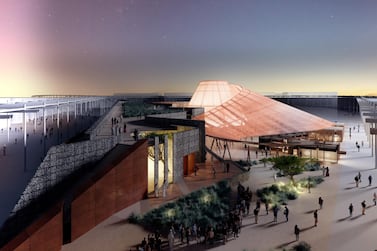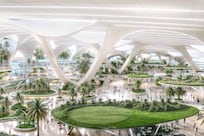Visitors to France’s pavilion at Expo 2020 Dubai will feel as though they have been transported into a glittering, Monet-inspired vision of the country’s sustainable future.
Although the design is modern, made from glass and steel to form a clean and angular structure, its creators are planning for a section of the luminous pavilion to feel like a walk through a French village.
When they enter the building, visitors will be surrounded by waves of light that appear to spread out and retreat from the artificial sky above, but will also be immersed in a sensory experience that will allow them to smell and hear the sounds of a traditional market.
French officials said they aim to build a spectacular structure in Dubai that will prompt debate and inspire innovations about connectivity in big cities.
The French pavilion will showcase three features of light: as a tool that illuminates; a source of heat; and as a medium for connections.
French President Emmanuel Macron said the pavilion would be a window into French innovation.
"Expo 2020 will be an opportunity to showcase a bold and positive vision of tomorrow's world," he said on Tuesday .
How much does it cost?
With a budget of €32 million (Dh137.6m), the Pavilion of Light costs twice what the pavilion at the Expo 2015 in Milan did four years ago. Officials hope the greater investment will attract more business.
“There is a difference in purpose with this expo. Milan, like the previous expos, was focused on the general public. This time the focus will be also on the business community. We plan to bring in all sectors involved in urban planning, be it transportation, energy, environment, public services or advertising,” said Erik Linquier, commissioner general for the France Expo 2020 Dubai.
The ground floor pavilion will comprise the main exhibition area and the top sections will feature an auditorium and seminar rooms.
What will it look like?
The exterior of the building will be paved with solar tiles. Each solar panel on the facade will reflect a shade of the French sky, also drawing inspiration from Monet's renowned impressionist painting Water Lilies.
“Constantly renewed, this living structure can be visited multiple times and it will never be the same. From dawn until dusk, every hour and every season, its shape will evolve, offering a brand new experience each time,” said Jean-Luc Perez, founder of Atelier du Prado, an architecture and urban planning agency.
The winning pavilion design was selected for its use of artificial and natural light over a 24-hour cycle.
Mr Linquier said the winning pavilion design captured the theme “Lumiere, Lumieres” or Light, Enlightenment.
"In French, it is the same word. But in English, it's two words that mean speed and energy. It is also enlightenment in connecting the mind and spirit," Mr Linquier said.
“The architects succeeded in making a pavilion devoted to light. It’s not merely about putting light on a building, it is how a building includes light during a visitor’s journey.”

Recreating a French market in Dubai
Visitors will be able to experience a little bit of Paris in Dubai when they enter the pavilion. They will feel as though they are wandering through gardens filled with olive and lemon trees, watch a light show and then step into the exhibition area which promises to plunge visitors into space and a time capsule.
One zone will take visitors to French landscapes with a mix of photographs, videos by artists and accompanied by scents designed by perfumer Dominique Ropion that will be diffused through the space.
Mobility as Expo 2020 Dubai’s theme
The French pavilion has been inspired by light as a symbol of mobility and will house projects by established companies, start-ups and research centres which will explore new modes of mobility.
"The main message we would like to convey is that mobility needs to be seamless. A city of 10 or 20 million people in China or India has the same issues of connectivity that London or Paris have faced," Mr Linquier said.
Construction of the pavilion begins in May on the Dubai South expo site and is expected to be completed by September next year.







